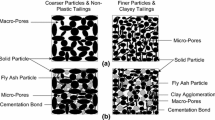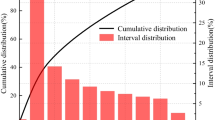Abstract
The objective of this study was to evaluate the effect of fly ash amendment on the compression behavior of mine tailings. Natural and synthetic (i.e., laboratory prepared) mine tailings were used to assess the effects of tailings composition and tailings solids content on compressibility. Three types of off-specification fly ashes and Type I–II Portland cement were used as cementitious binders. Tailings-fly ash mixtures were prepared at solids content of 60–75% (water content = 33–67%), water-to-binder ratios of 2.5 and 5, and were cured for 0.1 days (2 h), 7, and 28 days. Bi-linear compression curves on semi-log plots were observed in most of the binder-amended tailings specimens. The break in slope on the compression curve was identified as the breaking stress, whereupon cementitious bonds were broken. The breaking stress increased with an increase in fly ash content, which was attributed to a lower water-to-binder ratio and void volume-to-binder volume ratio that produced more effective particle bonding. Breaking stress also increased with an increase in CaO content and CaO-to-SiO2 ratio of fly ash, which resulted in more effective bonding between particles. The effect of curing time on the breaking stress of fly ash amended specimens was characterized by (1) an increase in breaking stress via increase in curing time and cementitious bond formation or (2) a constant breaking stress with curing time due to competing mechanisms during loading. Specimens cured under a vertical stress showed an increase in breakings stress with applied load water removal prior to cementitious bond formation that reduced the water-to-binder ratio and led to more effective cementation.















Similar content being viewed by others
References
Alhomair SA, Gorakhki MH, Bareither CA (2017) Hydraulic conductivity of fly ash-amended mine tailings. Geotech Geol Eng 35(1):243–261
ASTM (2007) Standard test method for particle-size analysis of soils, D 422-63, West Conshohocken
ASTM (2011) Standard test methods for one-dimensional consolidation properties of soils using incremental loading. D2435-11, West Conshohocken
ASTM (2014a) Standard test methods for liquid limit, plastic limit, and plasticity index of soils. D4318-10, West Conshohocken
ASTM (2014b) Standard test methods for specific gravity of soil solids by water pycnometer. D854-14, West Conshohocken
ASTM (2015) Standard specification for coal fly ash and raw or calcined natural pozzolan for use in concrete. C618-15, West Conshohocken
Aubertin M, Bussière B, Chapuis RP (1996) Hydraulic conductivity of homogenized tailings from hard rock mines. Can Geotech J 33(3):470–482
Belem T, Benzaazoua M, Bussière B (2000) Mechanical behavior of cemented paste backfill. In: Proceedings of 53rd Canadian geotechnical conference, pp 373–380
Benzaazoua M, Bussière B, Demers I, Aubertin M, Fried É, Blier A (2008) Integrated mine tailings management by combining environmental desulphurization and cemented paste backfill: application to mine Doyon, Quebec, Canada. Miner Eng 21(4):330–340
Blight G (2009) Geotechnical engineering for mine waste storage facilities. Taylor & Francis Group, London
Bobet A, Hwang J, Johnston CT (2011) One-dimensional consolidation behavior of cement-treated organic soil. Can Geotech J 48(7):1100–1115
Bowker LN, Chambers DM (2015). The risk, public liability, & economics of tailings storage facility failures. In: Earthwork Act
Bussière B (2007) Hydro-geotechnical properties of hard rock tailings from metal mines and emerging geo-environmental disposal approaches. Can Geotech J 44(9):1019–1052
Chesner WH, Collins RJ, MacKay MH (1998) User guidelines for waste and by-product materials in pavement construction (No. FHWA-RD-97-148)
Consoli NC, Montardo MD, Prietto PFM (2004) Effect of materials properties on the behavior of sand–cement–fiber composites. Gr Improv 8(2):77–90
Consoli NC, Foppa D, Festugato L, Heineck KS (2007) Key parameters for strength control of artificially cemented soils. J Geotech Geoenviron Eng 133(2):197–205
Consoli NC, Cruz RC, Floss MF, Festugato L (2009) Parameters controlling tensile and compressive strength of artificially cemented sand. J Geotech Geoenviron Eng 136(5):759–763
Daliri F, Kim H, Simms P, Sivathayalan S (2014) Impact of desiccation on monotonic and cyclic shear strength of thickened gold tailings. J Geotech Geoenviron Eng 140(9):1–13
Davies MP (2002) Tailings impoundment failure: are geotechnical engineers listening. Geotechnical News pp 31–36
Day K, Aldred J, Hudson B (2013) Concrete mix design, quality control and specification. Taylor & Francis Group, London
Duraisamy Y, Huat BB, Muniandy R (2009) Compressibility behavior of fibrous peat reinforced with cement columns. Geotech Geol Eng 27(5):619–629
Ercikdi B, Kesimal A, Cihangir F, Deveci H, Alp İ (2009) Cemented paste backfill of sulphide-rich tailings: importance of binder type and dosage. Cement Concr Compos 31(4):268–274
Ercikdi B, Baki H, İzki M (2013) Effect of desliming of sulphide-rich mill tailings on the long-term strength of cemented paste backfill. J Environ Manag 115:5–13
Fahey M, Helinski M, Fourie A (2011) Development of specimen curing procedures that account for the influence of effective stress during curing on the strength of cemented mine backfill. Geotech Geol Eng 29(5):709–723
Fall M, Benzaazoua M, Ouellet S (2005) Experimental characterization of the influence of tailings fineness and density on the quality of cemented paste backfill. Miner Eng 18(1):41–44
Fall M, Benzaazoua M, Saa EG (2008) Mix proportioning of underground cemented tailings backfill. Tunn Undergr Space Technol 23(1):80–90
Federico A, Vitone C, Murianni A (2015) On the mechanical behavior of dredged submarine clayey sediments stabilized with lime or cement. Can Geotech J 52(12):2030–2040
Godbout J, Bussière B, Belem T (2007) Evolution of cemented paste backfill saturated hydraulic conductivity at early curing time. Can Geotechn Soc, OttawaGeo, pp 2230–2236
Gorakhki MH, Bareither CA (2017) Unconfined compressive strength of mine tailings amended with fly ash. J Geotech Geoenviron Eng 143(7):1–14
Horpibulsuk S, Norihiko M, Nagaraj TS (2005) Clay–water/cement ratio identity for cement admixed soft clays. J Geotech Geoenviron Eng 131(2):187–192
Hudson-Edwards KA, Jamieson HE, Lottermoser BG (2011) Mine wastes: past, present, future. Elements 7(6):375–380
Janz M, Johansson SE (2002) The function of different binding agents in deep stabilization. In: 9th report of Swedish deep stabilization research centre, Linkoping
Kesimal A, Yilmaz E, Ercikdi B, Alp I, Deveci H (2005) Effect of properties of tailings and binder on the short-and long-term strength and stability of cemented paste backfill. Mater Lett 59(28):3703–3709
Khalili A, Wijewickreme D, Wilson GW (2005) Some observations on the mechanical response of mixtures of mine waste and tailings. In: Proceedings 58th Canadian geotechnical conference, Saskatoon, Sask, pp 18–21
Khalili A, Wijewickreme D, Wilson GW (2010) Mechanical response of highly gap-graded mixtures of waste rock and tailings. Part I: Monotonic shear response. Can Geotech J 47(5):552–565
Klein K, Simon D (2006) Effect of specimen composition on the strength development in cemented paste backfill. Can Geotech J 43(3):310–324
Kurtis K (2007) Structure of the hydrated cement paste. School of Civil Engineering, Georgia Institute of Technology, Atlanta
Misra M, Yang K, Mehta RK (1996) Application of fly ash in the agglomeration of reactive mine tailings. J Hazard Mater 51(1):181–192
Morris PH, Williams DJ (1997) Results of field trials of codisposal of coarse and fine coal waste. Trans Inst Min Metall 106:A38–A41
Nalbantoglu Z, Tuncer ER (2001) Compressibility and hydraulic conductivity of a chemically treated expansive clay. Can Geotech J 38(1):154–160
Nasir O, Fall M (2010) Coupling binder hydration, temperature and compressive strength development of underground cemented paste backfill at early ages. Tunn Undergr Space Technol 25(1):9–20
Ouellet S, Bussière B, Mbonimpa M, Benzaazoua M, Aubertin M (2006) Reactivity and mineralogical evolution of an underground mine sulphidic cemented paste backfill. Miner Eng 19(5):407–419
Ouellet S, Bussière B, Aubertin M, Benzaazoua M (2007) Microstructural evolution of cemented paste backfill: mercury intrusion porosimetry test results. Cem Concr Res 37(12):1654–1665
Pacheco-Torgal F, Labrincha J, Leonelli C, Palomo A, Chindaprasit P (eds) (2014) Handbook of alkali-activated cements, mortars and concretes. Elsevier, Cambridge, UK
Popovics S (1970) Concrete making materials. McGraw-Hill, New York, NY
Qiu Y, Sego DC (2001) Lab properties of mine tailings. Can Geotech J 38(1):183–190
Rotta GV, Consoli NC, Prietto PDM, Coop MR, Graham J (2003) Isotropic yielding in an artificially cemented soil cured under stress. Geotechnique 53(5):493–502
Schroeder RL (1994) The use of recycled materials in highway construction. Public Roads 58(2):32–41
Senol A, Edil TB, Bin-Shafique MS, Acosta HA, Benson CH (2006) Soft subgrades’ stabilization by using various fly ashes. Resour Conserv Recycl 46(4):365–376
Tariq A (2012) Synergistic and environmental benefits of using cement kiln dust with slag and fly ash in cemented paste tailings. Dissertation, Civil and Environmental Engineering, The University of Western Ontario
Tastan EO, Edil TB, Benson CH, Aydilek AH (2011) Stabilization of organic soils with fly ash. J Geotech Geoenviron Eng 137(9):819–833
Wickland BE, Wilson GW (2005) Self-weight consolidation of mixtures of mine waste rock and tailings. Can Geotech J 42(2):327–339
Wickland BE, Wilson GW, Wijewickreme D, Klein B (2006) Design and evaluation of mixtures of mine waste rock and tailings. Can Geotech J 43(9):928–945
Wickland BE, Wilson GW, Wijewickreme D (2010) Hydraulic conductivity and consolidation response of mixtures of mine waste rock and tailings. Can Geotech J 47(4):472-485
Yeheyis MB, Shang JQ, Yanful EK (2009) Long-term evaluation of coal fly ash and mine tailings co-placement: a site-specific study. J Environ Manag 91(1):237–244
Yilmaz E, Benzaazoua M, Belem T, Bussière B (2009) Effect of curing under pressure on compressive strength development of cemented paste backfill. Miner Eng 22(9):772–785
Yilmaz E, Belem T, Benzaazoua M, Bussière B (2010) Assessment of the modified CUAPS apparatus to estimate in situ properties of cemented paste backfill. Geotech Test J 33(5):1–12
Yilmaz E, Belem T, Benzaazoua M (2014) Effects of curing and stress conditions on hydromechanical, geotechnical and geochemical properties of cemented paste backfill. Eng Geol 168:23–37
Yilmaz E, Belem T, Bussière B, Mbonimpa M, Benzaazoua M (2015) Curing time effect on consolidation behavior of cemented paste backfill containing different cement types and contents. Constr Build Mater 75:99–111
Zhang L, Ahmari S, Zhang J (2011) Synthesis and characterization of fly ash modified mine tailings-based geopolymers. Constr Build Mater 25(9):3773–3781
Zhu F, Clark JI, Paulin MJ (1995) Factors affecting at-rest lateral stress in artificially cemented sands. Can Geotech J 32(2):195–203
Zou DH, Li LP (1999) Strengthening of solidified dilute tailings slurry. J Geotech Geoenviron Eng 125(1):11–15
Acknowledgements
Financial support for this study was provided in part by the Mountain Plains Consortium awarded to North Dakota State University. Support also was provided by the Colorado State University. The opinions, findings, and conclusions expressed herein are those of the authors and do not represent the views of the Mountain Plains Consortium, North Dakota State University, or Colorado State University.
Author information
Authors and Affiliations
Corresponding author
Rights and permissions
About this article
Cite this article
Gorakhki, M.H., Bareither, C.A. Compression Behavior of Mine Tailings Amended with Cementitious Binders. Geotech Geol Eng 36, 27–47 (2018). https://doi.org/10.1007/s10706-017-0299-4
Received:
Accepted:
Published:
Issue Date:
DOI: https://doi.org/10.1007/s10706-017-0299-4




